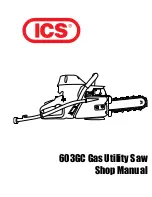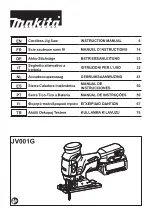
9
8
AMPERAGE
REQUIRED GAUGE FOR EXTENSION CORDS
25 ft.
50 ft.
100 ft.
150 ft.
10A
16 gauge
16 gauge
14 gauge
12 gauge
ELECTRICAL INFORMATION
IMPORTANT:
Servicing a double-insulated product requires extreme care and knowledge of the system, and should
be done only by qualified service personnel using identical replacement parts. Always use original factory replace-
ment parts when servicing.
1. Polarized Plugs. To reduce the risk of electric shock, this equipment has a polarized plug (one blade is wider than
the other). This plug will fit in a polarized outlet only one way. If the plug does not fit fully in the outlet, reverse the
plug. If it still does not fit, contact a qualified electrician to install a proper outlet. Do not modify the machine plug
or the extension cord in any way.
2. Ground fault circuit interrupter protection (GFCI) should be provided on the circuit or outlet used for this power
tool to reduce the risk of electric shock.
3. Service and repair. To avoid danger, electrical appliances must only be repaired by qualified service technician
using original replacement parts.
GUIDELINES AND RECOMMENDATIONS FOR EXTENSION CORDS
When using an extension cord, be sure to use one heavy enough to carry the current your product will draw. An
undersized cord will cause a drop in line voltage resulting in loss of power and overheating. The table below shows
the correct size to be used according to cord length and ampere rating. When in doubt, use a heavier cord. The
smaller the gauge number, the heavier the cord.
DOUBLE-INSULATED TOOLS
The tool’s electrical system is double insulated where two systems of insulation are provided. This
eliminates the need for the usual three-wire grounded power cord. Double insulated tools do not need
to be grounded, nor should a means for grounding be added to the product. All exposed metal parts
are isolated from the internal metal motor components with protecting insulation.
1. EXAMINE EXTENSION CORD BEFORE USE. Make sure your extension cord is properly wired and in good condi-
tion. Always replace a damaged extension cord or have it repaired by a qualified person before using it.
2. DO NOT ABUSE EXTENSION CORD. Do not pull on cord to disconnect from receptacle; always disconnect by pull-
ing on plug. Disconnect the extension cord from the receptacle before disconnecting the product from the extension
cord. Protect your extension cords from sharp objects, excessive heat and damp/wet areas.
3. USE A SEPARATE ELECTRICAL CIRCUIT FOR YOUR TOOL. This circuit must not be less than a 12-gauge wire
and should be protected with a 15A time-delayed fuse. Before connecting the motor to the power line, make sure
the switch is in the OFF position and the electric current is rated the same as the current stamped on the motor
nameplate. Running at a lower voltage will damage the motor.










































